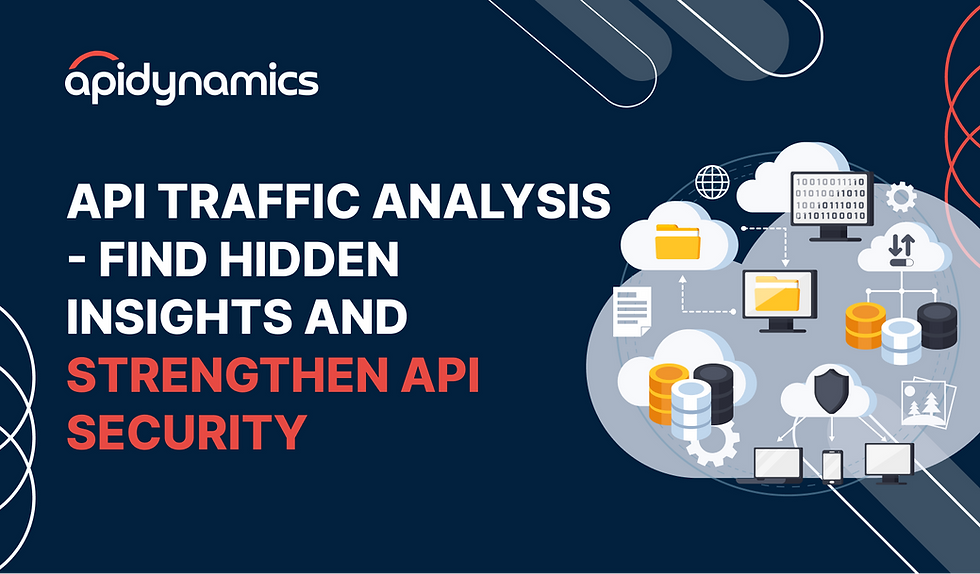Why Existing API Security Solutions Are Falling Short on Real-Time Protection
- APIDynamics
- Jul 27
- 4 min read
By Tippu Gagguturu
Founder & CEO, APIDynamics

APIs have evolved from technical glue to the nervous system of modern business. They power mobile apps, orchestrate microservices, and now serve as the gateway to AI agents and machine-to-machine communication.
With this evolution, a new wave of API security platforms has emerged, promising to protect the enterprise from this rapidly expanding attack surface. Yet, most of them stop short of the one thing security leaders actually need — real-time protection.
Instead, the vast majority of these solutions provide visibility, monitoring, and post-mortem insights.They show you what went wrong — but not while it's happening.
This is a critical flaw. And here’s why.
1. Out-of-Band Detection Can’t Keep Up with In-Band Attacks
Many API security platforms rely on out-of-band traffic analysis. They sit outside the path of the request, consuming mirrored traffic from gateways or packet brokers. This model is appealing because it:
Doesn't affect latency
Doesn’t require code changes
Doesn’t risk breaking production systems
But there's a catch: you can't protect what you don't control in real time.
These solutions:
Detect misconfigurations, attacks, or anomalous behavior after the request is processed
Alert security teams hours (or days) after the incident
Can’t block malicious API requests in-flight
So when an attacker uses a valid API key to exfiltrate customer PII?
You’ll know tomorrow. Not when it mattered.
2. Static Credentials = Static Trust = Breach Waiting to Happen
Today’s machine identities are still mostly secured by:
Hardcoded API keys
Long-lived OAuth tokens
Static service accounts
Shared secrets
They’re convenient. But they're also incredibly dangerous.
They’re not tied to a specific device, context, or workload. So if an attacker gets their hands on one (and they often do via CI/CD leaks, logs, repos, or headers), they can:
Impersonate services
Move laterally across APIs
Bypass traditional Zero Trust policies
Most existing solutions detect misuse of these credentials after the fact.But they don’t challenge them, rotate them, or restrict them dynamically.
In human authentication, we’ve evolved — adaptive MFA, device fingerprinting, behavioral detection. In machine authentication, we’re stuck in 2008.
3. Visibility ≠ Protection
Let’s be clear: visibility is important.
Modern API security platforms do a good job at:
Discovering APIs across environments
Reconstructing OpenAPI specs
Monitoring usage patterns
Flagging anomalies
But here’s the problem: this is all passive.
They don’t terminate suspicious sessions
They don’t enforce runtime risk policies
They don’t do inline authentication
They don’t verify context like geo, time, device, or behavior
In short: they tell you when something might be wrong.
But they don’t stop it from happening.
4. Static Policies in a Dynamic World
APIs today are:
Auto-generated
Deployed with CI/CD pipelines
Used by ephemeral containers and AI agents
Hit by internal bots and third-party vendors
This is a fluid, fast-moving environment.
Yet traditional API security tools rely on:
Predefined signatures
Static thresholds
Hard-coded allow/deny rules
These brittle policies can’t keep up with:
Shifting baselines
Polyglot services
AI-driven usage
What’s needed: an enforcement model that reacts at runtime based on risk signals — not on pre-baked assumptions.
5. Zero Trust Has a Blind Spot: APIs
Zero Trust has become the north star of modern cybersecurity.
We’ve applied it to:
User access (MFA, device posture, behavior-based auth)
Networks (micro-segmentation, identity-based routing)
Data (encryption, access control)
But APIs?
Too often, they’re assumed secure if:
They’re behind a gateway
They require a token
They’re documented
The truth is, most gateways only check the token once, and then trust every downstream request.
There’s no continuous verification.No context-aware authentication.No challenge for anomalous behavior.
And existing API security tools don’t fill that gap.
Why This Matters Now
The landscape is shifting. Fast.
✅ AI-native applications are making API calls autonomously
✅ Agentic software is triggering workflows based on inference
✅ Machine-to-machine APIs outnumber human-to-service logins by 10x
✅ Regulations like PCI, HIPAA, and DORA are demanding tighter runtime controls
The tools built for yesterday’s world — of scheduled audits and static environments — can’t handle what’s coming next.
What Real-Time API Security Should Look Like
To truly secure APIs in today’s world, we need platforms that can:
✅ Verify every API call at runtime
✅ Challenge high-risk calls with adaptive MFA for machines
✅ Score requests based on context, not just identity
✅ Enforce just-in-time access with tokenless flows or short-lived tokens
✅ Terminate or step-up authentication on the fly
That’s not just visibility. That’s enforcement.That’s not monitoring. That’s machine-first Zero Trust.
Enter APIDynamics
We built APIDynamics because no one else was solving this.
We asked: What if APIs could authenticate like humans — dynamically, contextually, and with real-time step-up when needed?
And we answered with:
An adaptive MFA engine for machine-to-machine API calls
A runtime enforcement layer that blocks, challenges, or escalates
A platform that eliminates static secrets and verifies risk per call
Inline control — not just dashboards
The Future of API Security Is Real-Time
If you're still relying on tools that only offer visibility, you’re flying blind at runtime.
APIs don’t just need to be watched. They need to be protected. In real time. With intelligent, contextual decisions.
The threats are faster now. Your defenses need to be too.
Let’s move API security out of the dashboards—and into the data path.
🔐 Want to see how real-time adaptive API authentication works?
Try now https://developer.apidynamics.sevenhills.ai/register or schedule a demo.




Comments